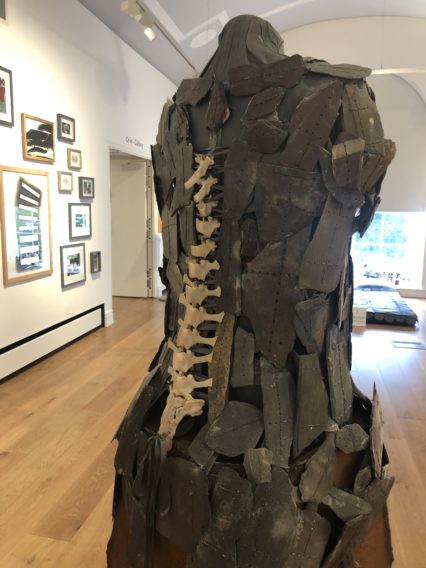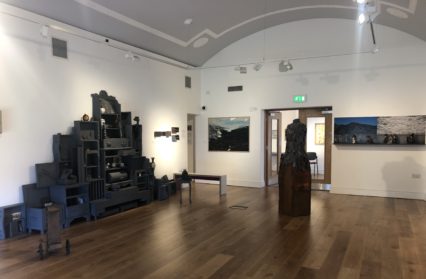Nicola Edwards explores the powerful symbolism embedded into the Merched Chwarel exhibition in Bangor’s Storiel space.

Merched Chwarel is a very necessary collaboration of four female artists who live and work in the quarrying communities of North Wales. The outcome is a powerful examination of women’s roles in an industrial environment that is conventionally a very masculine domain.
Marged Pendrell, Jwls Williams, Lisa Hudson and Lindsey Colbourne all explore how slate permeated the lives of women in quarrying communities, and how their traditions and habits were born from an almost stifling need for a collective identity and memory.
The Groaning Dresser, involving all four artists and the curator, Jill Piercy, is a striking amalgamation of the domestic; tables, drawers, bread bins and keepsake boxes, all painted in slate grey and constructed to resemble the quarrying landscape. However, unlike the abandoned slag heaps of the Penrhyn or Ffestiniog quarries, the exhibition’s centrepiece is a celebration of female identity and memory. The dresser is filled with porcelain and glass, all donated by the artists’ family, friends and neighbours, reinforcing the collaborative nature of the piece. As more pieces are donated, the dresser is intended to groan with the weight of collective identity and memory, affirming its position as the exhibition’s ideological and thematic cynosure.
The centrality of the Groaning Dresser does not, however, detract from the many other fascinating installations. Lisa Hudson’s Mam’s Dress is an imposing piece that is less a celebration of memory, and more a statement on how women were metaphorically weighed down by the slate industry. The dress, which comprises slate off-cuts, is endowed with a second layer of meaning by the spine that is attached to the exterior of the dress, implying that women did not merely wear the landscape, but that it was within them and a part of their anatomy.
Similarly to Mam’s Dress, Marged Pendrell combines the masculinity of the slate industry with female craftwork in her piece, The Slate Quilt Bed. There are echoes of slate roofing, which she merges with the femininity of the patchwork quilt. This domestication of the masculine is an interesting and crucial reversal of gender archetypes.
This reversal of gender models is a central theme in the exhibition. From Lindsey Colbourne’s playful Welsh Doll Series, where she transposes the incongruous stereotype of the Welsh Lady into a quarrying landscape, to Marged Pendrell’s mixed-media Dresser Fragments, which explore in miniature the impact of women in both the domestic sphere and their contribution to the industrial life of the area. These pieces are stitched together by Jwls Williams’ emotive and powerful paintings of Penmaenmawr Quarry, where three generations of her family lived and worked.
The artists’ affinity with both the landscape and the communities of slate villages is one of many strengths of this exhibition. There is a deep understanding and appreciation of the roles women played in the masculine topography of the North Wales quarries, both past and present. Merched Chwarel is therefore an essential re-evaluation of the female identity and its place amongst the male-dominated slate industry.
Merched Chwarel is in Storiel Bangor until 7th September.
Nicola Edwards is a regular contributor to Wales Arts Review.












